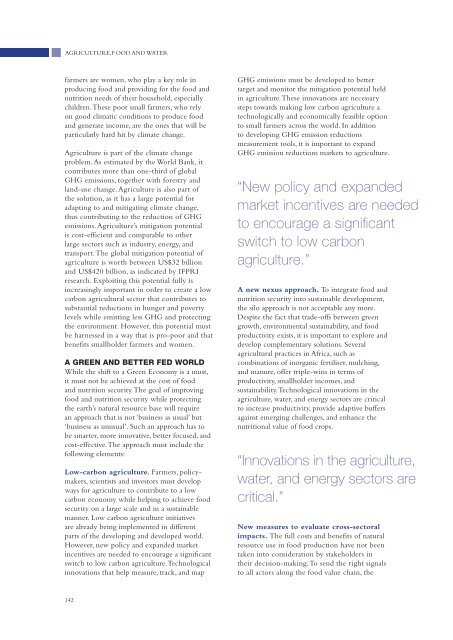Climate Action 2012-2013
Create successful ePaper yourself
Turn your PDF publications into a flip-book with our unique Google optimized e-Paper software.
AGRICULTURE, FOOD AND WATER<br />
farmers are women, who play a key role in<br />
producing food and providing for the food and<br />
nutrition needs of their household, especially<br />
children. These poor small farmers, who rely<br />
on good climatic conditions to produce food<br />
and generate income, are the ones that will be<br />
particularly hard hit by climate change.<br />
Agriculture is part of the climate change<br />
problem. As estimated by the World Bank, it<br />
contributes more than one-third of global<br />
GHG emissions, together with forestry and<br />
land-use change. Agriculture is also part of<br />
the solution, as it has a large potential for<br />
adapting to and mitigating climate change,<br />
thus contributing to the reduction of GHG<br />
emissions. Agriculture’s mitigation potential<br />
is cost-efficient and comparable to other<br />
large sectors such as industry, energy, and<br />
transport. The global mitigation potential of<br />
agriculture is worth between US$32 billion<br />
and US$420 billion, as indicated by IFPRI<br />
research. Exploiting this potential fully is<br />
increasingly important in order to create a low<br />
carbon agricultural sector that contributes to<br />
substantial reductions in hunger and poverty<br />
levels while emitting less GHG and protecting<br />
the environment. However, this potential must<br />
be harnessed in a way that is pro-poor and that<br />
benefits smallholder farmers and women.<br />
A GREEN AND BETTER FED WORLD<br />
While the shift to a Green Economy is a must,<br />
it must not be achieved at the cost of food<br />
and nutrition security. The goal of improving<br />
food and nutrition security while protecting<br />
the earth’s natural resource base will require<br />
an approach that is not ‘business as usual’ but<br />
‘business as unusual’. Such an approach has to<br />
be smarter, more innovative, better focused, and<br />
cost-effective. The approach must include the<br />
following elements:<br />
Low-carbon agriculture. Farmers, policymakers,<br />
scientists and investors must develop<br />
ways for agriculture to contribute to a low<br />
carbon economy while helping to achieve food<br />
security on a large scale and in a sustainable<br />
manner. Low carbon agriculture initiatives<br />
are already being implemented in different<br />
parts of the developing and developed world.<br />
However, new policy and expanded market<br />
incentives are needed to encourage a significant<br />
switch to low carbon agriculture. Technological<br />
innovations that help measure, track, and map<br />
GHG emissions must be developed to better<br />
target and monitor the mitigation potential held<br />
in agriculture. These innovations are necessary<br />
steps towards making low carbon agriculture a<br />
technologically and economically feasible option<br />
to small farmers across the world. In addition<br />
to developing GHG emission reductions<br />
measurement tools, it is important to expand<br />
GHG emission reductions markets to agriculture.<br />
“New policy and expanded<br />
market incentives are needed<br />
to encourage a significant<br />
switch to low carbon<br />
agriculture.”<br />
A new nexus approach. To integrate food and<br />
nutrition security into sustainable development,<br />
the silo approach is not acceptable any more.<br />
Despite the fact that trade-offs between green<br />
growth, environmental sustainability, and food<br />
productivity exists, it is important to explore and<br />
develop complementary solutions. Several<br />
agricultural practices in Africa, such as<br />
combinations of inorganic fertiliser, mulching,<br />
and manure, offer triple-wins in terms of<br />
productivity, smallholder incomes, and<br />
sustainability. Technological innovations in the<br />
agriculture, water, and energy sectors are critical<br />
to increase productivity, provide adaptive buffers<br />
against emerging challenges, and enhance the<br />
nutritional value of food crops.<br />
“Innovations in the agriculture,<br />
water, and energy sectors are<br />
critical.”<br />
New measures to evaluate cross-sectoral<br />
impacts. The full costs and benefits of natural<br />
resource use in food production have not been<br />
taken into consideration by stakeholders in<br />
their decision-making. To send the right signals<br />
to all actors along the food value chain, the<br />
142












